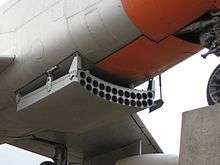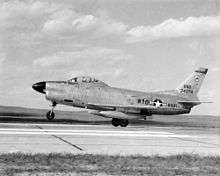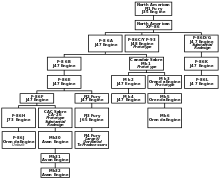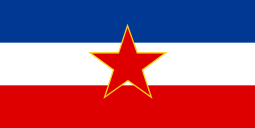North American F-86D Sabre
| F-86D/K/L Sabre | |
|---|---|
 | |
| The fifth F-86D for the USAF in formation with two other early production aircraft | |
| Role | Fighter interceptor |
| Manufacturer | North American Aviation |
| First flight | 22 December 1949, 67 years ago |
| Primary users | United States Air Force Italian Air Force SFR Yugoslav Air Force Venezuelan Air Force |
| Number built | 2,847 |
| Unit cost | |
| Developed from | North American F-86 Sabre |
The North American F-86D Sabre (sometimes called the "Sabre Dog" or "Dog Sabre") was a transonic jet all-weather interceptor of the United States Air Force and others. Based on North American's F-86 Sabre day fighter, the F-86D had only 25 percent commonality with other Sabre variants, with a larger fuselage, larger afterburner engine, and a distinctive nose radome.
Design and development
The YF-95 was a development of the F-86 Sabre, the first aircraft designed around the new 2.75-inch (70 mm) "Mighty Mouse" Folding-Fin Aerial Rocket (FFAR). Begun in March 1949, the unarmed prototype, 50-577, first flew on 22 December 1949, piloted by North American test pilot George Welch and was the first U.S. Air Force night fighter design with only a single crewman and a single engine, a J47-GE-17 with afterburner rated at 5,425 lbf (24.1 kN) static thrust. Gun armament was eliminated in favor of a retractable under-fuselage tray carrying 24 unguided Mk. 4 rockets, then considered a more effective weapon against enemy bombers than a barrage of cannon fire. A second prototype, 50-578, was also built, but the YF-95 nomenclature was short-lived as the design was subsequently redesignated YF-86D.

The fuselage was wider and the airframe length increased to 40 ft 4 in (12.29 m), with a clamshell canopy, enlarged tail surfaces and AN/APG-36 all-weather radar fitted in a radome in the nose, above the intake. Later models of the F-86D received an uprated J-47-GE-33 engine rated at 5,550 lbf (24.7 kN) (from the F-86D-45 production blocks onward). A total of 2,504 D-models were built.
Operational history
On 18 November 1952, F-86D, 51-2945, set a speed record of 698.505 mph (1,124.1 km/h). Captain J. Slade Nash flew over a three km (1.8 mi.) course at the Salton Sea in southern California at a height of only 125 ft (38 m). Another F-86D broke this world record on 16 July 1953, when Lieutenant Colonel William F. Barns, flying F-86D 51-6145, in the same path of the previous flight, achieved 715.697 mph (1,151.8 km/h).

Variants

- YF-95A
- prototype all-weather interceptor; two built; designation changed to YF-86D (North American model NA-164)
- YF-86D
- originally designated YF-95A.
- F-86D
- Production interceptor originally designated F-95A, 2,504 built.
- F-86G
- Provisional designation for F-86D variant with uprated engine and equipment changes, 406 built as F-86Ds.
- YF-86K
- Basic version of F-86D intended for export with rocket tray replaced by four 20 mm cannon and simplified fire control system, two conversions.
- F-86K
- NATO version of F-86D; MG-4 fire control system; four 20 mm M24A1 cannon with 132 rounds per gun; APG-37 radar. 120 were built by North American, 221 were assembled by Fiat.
- F-86L
- Upgrade conversion of F-86D with new electronics, extended wingtips and wing leading edges, revised cockpit layout, and uprated engine; 981 converted.
Operators
- Source: Dorr[2]



- Received 59 ex-USAF F-86Ds 1958-1960; assigned to 723, 726 and 728 Squadrons.
 France
France
- Fiat built 62 F-86Ks for France (1956-1957), assigned to EC 1/13 Artois, EC 2/13 Alpes, and EC 3/13 Squadrons. Serials were 55-4814/4844, 55-4846/4865, 55-4872/4874, 55-4876/4879.
 Germany
Germany
- Acquired 88 U.S. F-86Ks 22 July 1957–23 June 1958. The Ks were assigned to Jagdgeschwader 75/renamed 74.
 Greece
Greece
- Acquired some U.S. F-86Ds were received in 1961 (no details).
 Honduras
Honduras
- Acquired Six Venezuelan F-86Ks in 1970.
 Italy
Italy
- Fiat produced 121 F-86Ks for Italy, 1955-1958. Also, 120 U.S. F-86Ks were acquired. F-86s were assigned to the AMI air groups: 6 Gruppo COT/1 Stormo, 17 Gruppo/1 Stormo, 23 Gruppo/1 Stormo, 21 Gruppo/51 Aerobrigata, 22 Gruppo/51 Aerobrigata and 12 Gruppo/4 Aerobrigata.
 Japan
Japan
- Acquired 122 US F-86Ds, 1958–1961; assigned to four all-weather interceptor Hikōtai, and Air Proving Ground at Gifu.
 Netherlands
Netherlands
- Royal Netherlands Air Force (Koninklijke Luchtmacht) (KLu)
- Acquired 57 U.S.-built and six Fiat-built F-86K Sabres, 1955–1956; and assigned to three squadrons, No. 700, 701 and 702. Operated until 1964.
 Norway
Norway
- Acquired 60 U.S.-built F-86K Sabres, 1955–1956, and four Italian-assembled Fiat K-models.
.svg.png) Philippines
Philippines
- Acquired 20 F-86Ds, assigned to 8th Fighter Interceptor Squadron "Vampires" beginning 1960; part of the U.S. military assistance package.
 South Korea
South Korea
- Acquired 40 F-86Ds, beginning 20 June 1955.
 Republic of China (Taiwan)
Republic of China (Taiwan)
- Acquired 50 US-built F-86Ds, and 40 F-86Ks.
 Thailand
Thailand
- Acquired 20 F-86Ls.
 United States
United States
- Acquired 32 US-built F-86Fs, October 1955–December 1960; 1965 acquired 79 Fiat-built F-86Ks from West Germany.
 Yugoslavia
Yugoslavia
- Acquired 130 U.S.-made F-86Ds and operated them between 1961 and 1974.
Survivors

Many Sabres of several different Marks are preserved around the world, some examples being:
- F-86D Sabre, Former Louisiana Air National Guard, on display at Jackson Barracks New Orleans.
- F-86D Sabre, 51-6171, Former USAF & Greek AF (as 6171), on display at the North East Aircraft Museum, United Kingdom
- F-86D Sabre, 51-8453, Danish F-453, Danish AF, Copenhagen, Denmark.[3]
- F-86D Sabre, 52-3863, National Museum of the United States Air Force, Wright-Patterson Air Force Base, Ohio.
- F-86D Sabre, 52-10023 Yugoslav 14102, YUAF, manufacturers number 190-748, at Yugoslav Aeronautical Museum, Nikola Tesla Airport, Belgrade, Serbia.
- F-86K Sabre, 54812, Italian 51-3, Italian AF, manufactured by Fiat, Museo della Scienza e della Tecnologia "Leonardo da Vinci", Milan, Italy.
- F-86L Sabre, 53-0965 Pima Air Museum, Tucson Arizona
- F-86L Sabre Jimmy Doolittle Air and Space Museum at Travis AFB California
- F-86L Sabre 52-4191, Pacific Aviation Museum Pearl Harbor, Pearl Harbor, Hawaii [4]
- F-86D-60-NA Sabre "53-1030" (F-86L) now on display at NAS Fort Worth JRB, TX
- F-86L Sabre, 52-4142, Carolinas Aviation Museum Charlotte NC
- F-86D Sabre, "53-1060", Yankee Air Museum, Belleville, Michigan
- F-86L Sabre, (cockpit and nose) "53-4036", Derilect Aircraft Museum, Launching Place, Victoria, Australia
Specifications (F-86D-40-NA)

Data from Combat Aircraft since 1945,[5] The American Fighter [6]
General characteristics
- Crew: one
- Length: 40 ft 3 in (12.27 m)
- Wingspan: 37 ft 1.5 in (11.31 m)
- Height: 15 ft in (4.57 m)
- Empty weight: 13,518 lb (6,132 kg)
- Gross weight: 19,975 lb (9,060 kg)
- Powerplant: 1 × General Electric J47-GE-17B, 5,425 lbf (24.1 kN)dry, 7,500 lbf (33.4 kN) with afterburner
Performance
- Maximum speed: 693 mph (1,115 km/h)
- Maximum speed: Mach .91
- Range: 330 miles (531 km)
- Service ceiling: 49,750 ft (15,163 m)
- Rate of climb: 12,150 ft/min (61.7 m/s)
Armament
- 24 × 2.75 in (70 mm) Mighty Mouse FFAR rockets in ventral tray
See also
- Aerospace Defense Command
- North American Aerospace Defense Command
- Semi-Automatic Ground Environment
- Related development
- CAC Sabre
- Canadair Sabre
- North American F-86 Sabre
- North American F-100 Super Sabre
- North American FJ-1 Fury
- North American FJ-2/-3 Fury
- North American FJ-4 Fury
- North American YF-93
- Aircraft of comparable role, configuration and era
- Douglas F3D Skyknight
- Douglas F4D Skyray
- Lockheed F-94 Starfire
- Mikoyan-Gurevich MiG-17
- Northrop F-89 Scorpion
- Saab 29 Tunnan
- Supermarine Swift
- Related lists
References
Notes
Bibliography
- Allward, Maurice. F-86 Sabre. London: Ian Allen, 1978. ISBN 0-7110-0860-4.
- Angelucci, Enzo and Peter Bowers. The American Fighter: the Definite Guide to American Fighter Aircraft from 1917 to the Present. New York: Orion Books, 1987. ISBN 0-517-56588-9.
- Curtis, Duncan. North American F-86 Sabre. Ramsbury, UK: Crowood, 2000. ISBN 1-86126-358-9.
- Dorr, Robert F. F-86 Sabre Jet: History of the Sabre and FJ Fury. St. Paul, Minnesota: Motorbooks International Publishers, 1993. ISBN 0-87938-748-3.
- Käsmann, Ferdinand C.W. Die schnellsten Jets der Welt: Weltrekord- Flugzeuge (in German). Oberhaching, Germany: Aviatic Verlag-GmbH, 1994. ISBN 3-925505-26-1.
- Knaack, Marcelle Size. Encyclopedia of US Air Force Aircraft and Missile Systems, Volume 1, Post-World War Two Fighters, 1945-1973. Washington, DC: Office of Air Force History, 1978. ISBN 0-912799-59-5.
- Swanborough, F. Gordon. United States Military Aircraft Since 1909. London: Putnam, 1963. ISBN 0-87474-880-1.
- Wagner, Ray. American Combat Planes - Second Edition. Garden City, New York: Doubleday and Company, 1968. ISBN 0-370-00094-3.
- Wagner, Ray. The North American Sabre. London: Macdonald, 1963. No ISBN.
- Westrum, Ron. Sidewinder. Annapolis, Maryland: Naval Institute Press, 1999. ISBN 1-55750-951-4.
- Wilson, Stewart. Combat Aircraft since 1945. Fyshwick, ACT, Australia: Aerospace Publications Pty Ltd, 2000. ISBN 1-875671-50-1.
External links
| Wikimedia Commons has media related to F-86D/K/L Sabre Squadron Emblems. |
| Wikimedia Commons has media related to North American F-86D/K/L Sabre. |
- (1960) T.O. 1F-86K-1 Flight Manual USAF Series F-86K Aircraft
- Globalsecurity.org profile of the F-86D/L Sabre
- Four-part series about the F-86 Sabre – Extended F-86 Sabre article set
- Sabre site
- North American F-86D Sabre
- Aviation Museums of the World